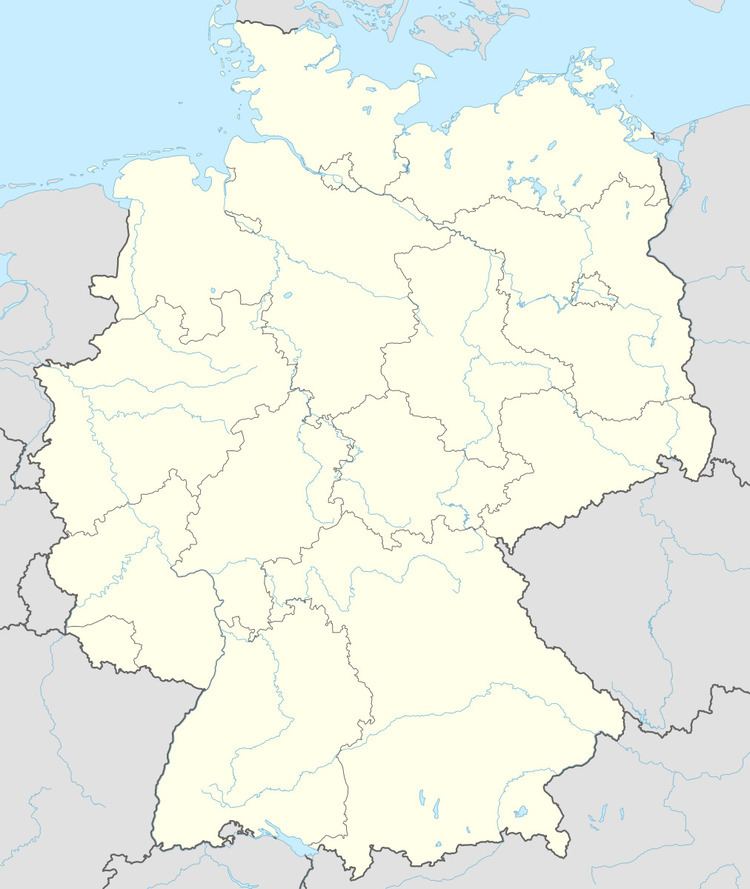District Greiz Postal codes 07980 Area 43.49 km² Population 3,656 (31 Dec 2008) Dialling code 036623 | Time zone CET/CEST (UTC+1/+2) Dialling codes 036623 Local time Saturday 5:22 PM Postal code 07980 | |
 | ||
Weather 14°C, Wind SE at 10 km/h, 49% Humidity | ||
Berga/Elster is a town in the district of Greiz, in Thuringia, Germany. It is situated on the White Elster river, 14 km southeast of Gera.
Contents
Map of Berga, Germany
History
Within the German Empire (1871-1918), Berga/Elster was part of the Grand Duchy of Saxe-Weimar-Eisenach.
Berga Concentration Camp
During World War II, a slave labor camp called "Berga an der Elster" was operated here to dig 17 tunnels for an underground ammunition factory. Workers were supplied by Buchenwald concentration camp and from a POW camp, Stalag IX-B; the latter contravened the provisions of the Third Geneva Convention and of the Hague Treaties. Many prisoners died as a result of malnutrition, sickness (including pulmonary disease due to dust inhalation from tunnelling with explosives), and beatings, including 73 American POWs. The labor camp formed part of Germany's secret plan to transform, via hydrogenation, brown coal into usable fuel for tanks, planes, and other military machinery. However, the camp's additional purpose was Vernichtung durch Arbeit (or "annihilation through labor"), and prisoners were intentionally worked to death with inhumane working and living conditions, and starvation. This secondary purpose of extermination was carried out until the war's end, when the prisoners were subjected to a forced death march to keep ahead of the advancing allied forces.
POWs were put to work, together with concentration camp inmates, digging 17 tunnels for an underground ammunition factory, some of them 150 feet below ground. As a result of the appalling conditions, malnutrition and cold, as well as beatings, 47 prisoners died. The U.S. military authorities never acknowledged the incident.
On 4 April, the 300 surviving American prisoners were marched out of the camp ahead of approaching American troops. After a 2½-week forced march they were finally liberated. During this march another 36 Americans died.
During an air-raid, while the camp lights were extinguished, Hans Kasten, Joe Littel and Ernst Sinner,escaped from the Berga camp. They were later arrested and taken to Gestapo headquarters. After identification as POWs they were taken to Buchenwald and placed in detention cells. They were freed when the KZ Buchenwald was liberated.
Berga was run by a fanatical German national guard sergeant named Erwin Metz, who was responsible for the inhumane conditions and who gave the order to take the prisoners on the death march. When the allied forces closed in on the retreating Germans, Metz deserted his post and attempted to escape by bicycle, fearing the consequences of being captured in possession of the remaining Berga prisoners and having to answer for his war crimes. Still, he was captured days after the prisoners were liberated by American forces, and he was sentenced to death, because he had killed a US POW, Pvt Morton Goldstein (Battery C/590th Field Artillery/106 US Division) on March 14, 1945. However, because of the American political climate and the shifting priorities of the American War Department toward defending against the Soviets in the lead-up to the Cold War, many German war criminals' sentences were commuted in exchange for intelligence that the Western allies believed could be used against the Soviets. Metz thus was instead sentenced to twenty years' imprisonment, though in the end he served only nine before being released back into Germany a free man.
